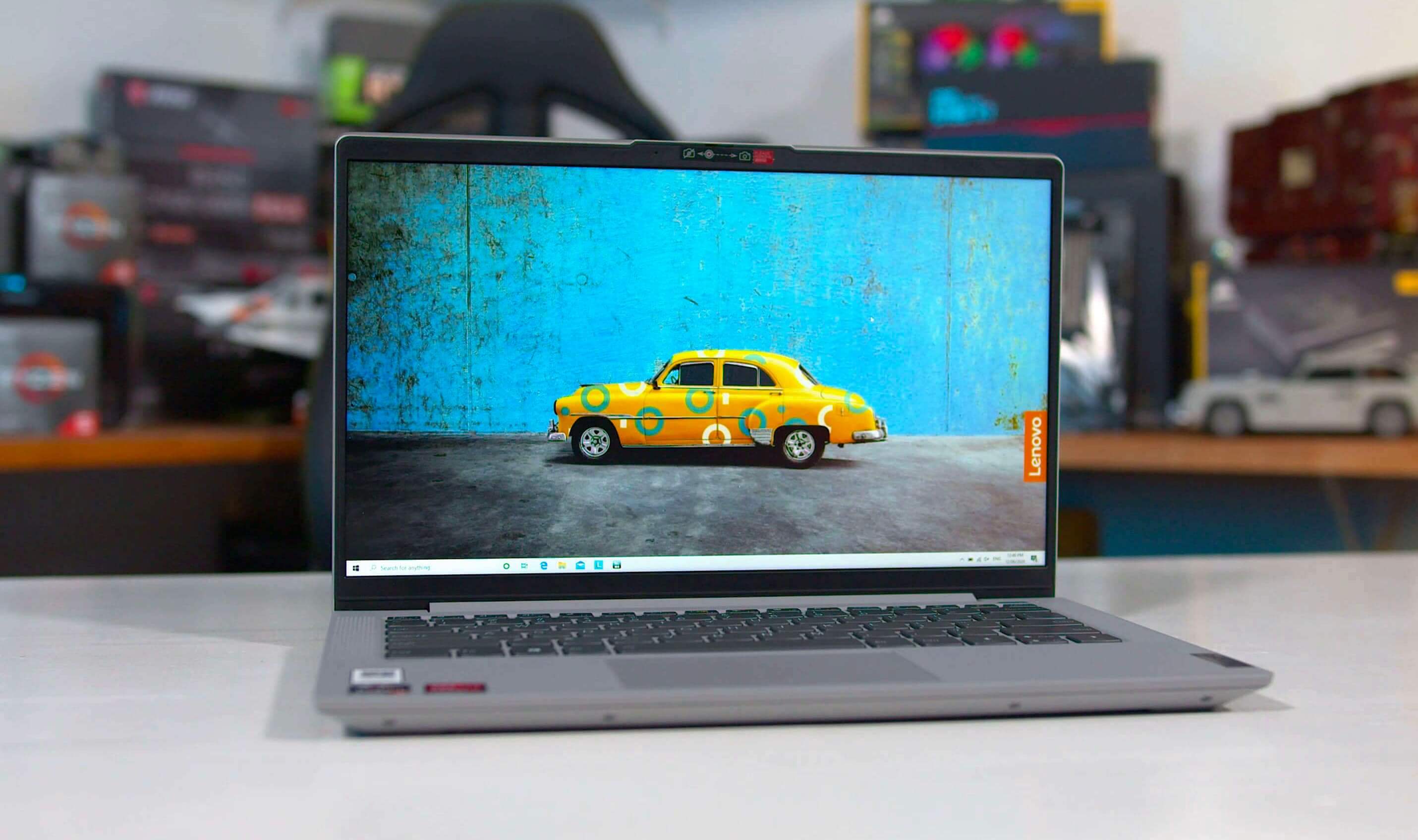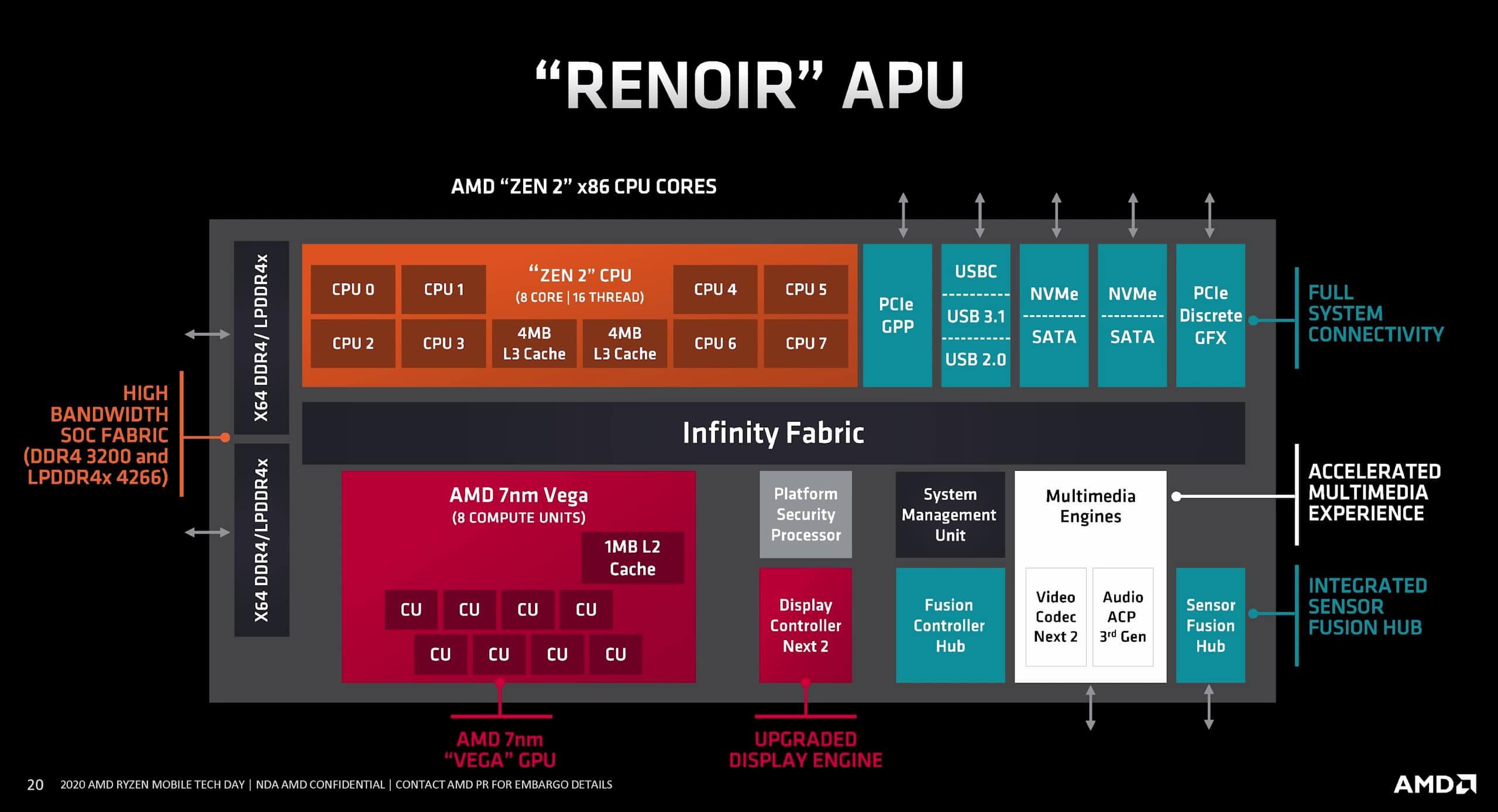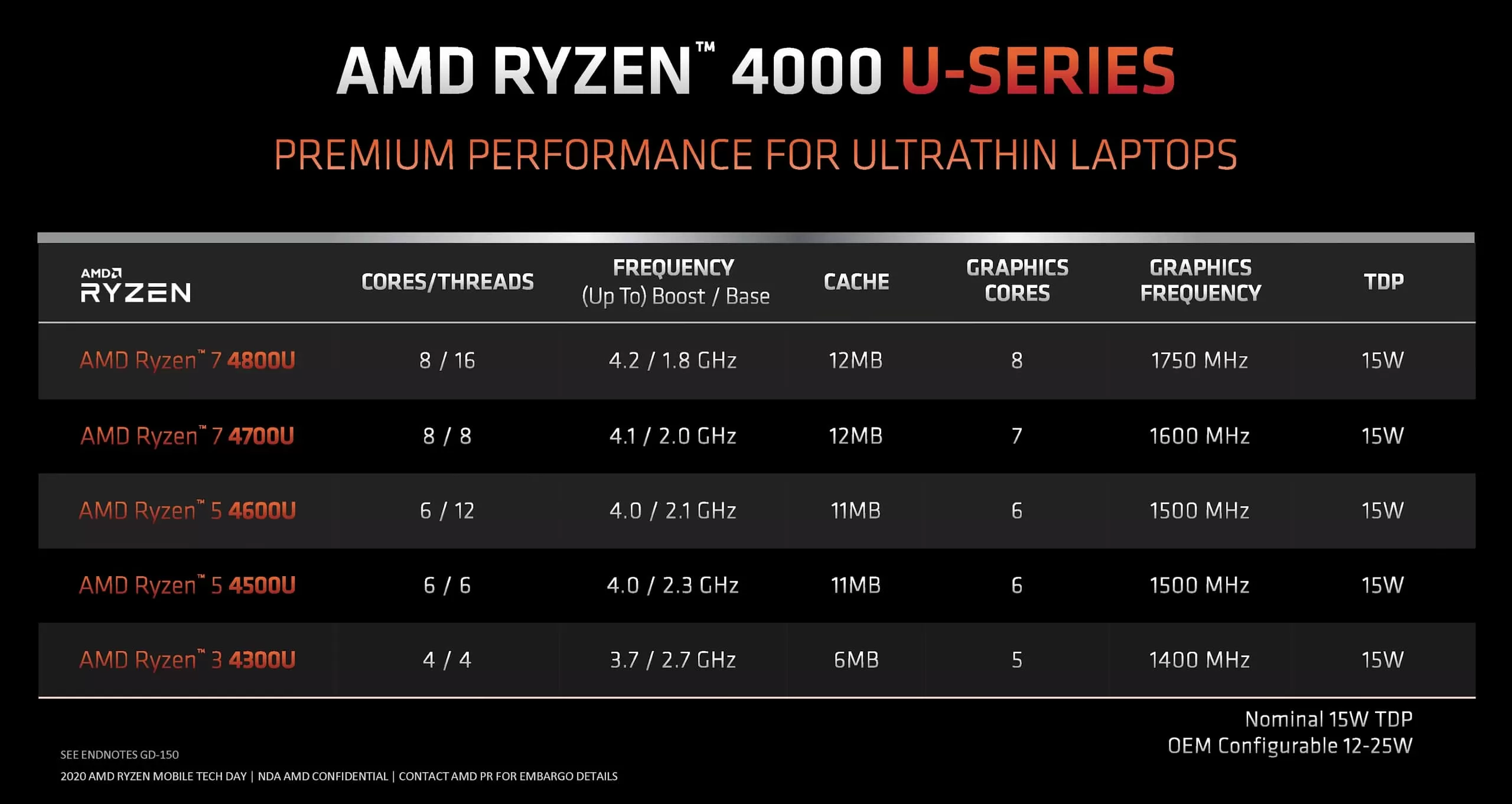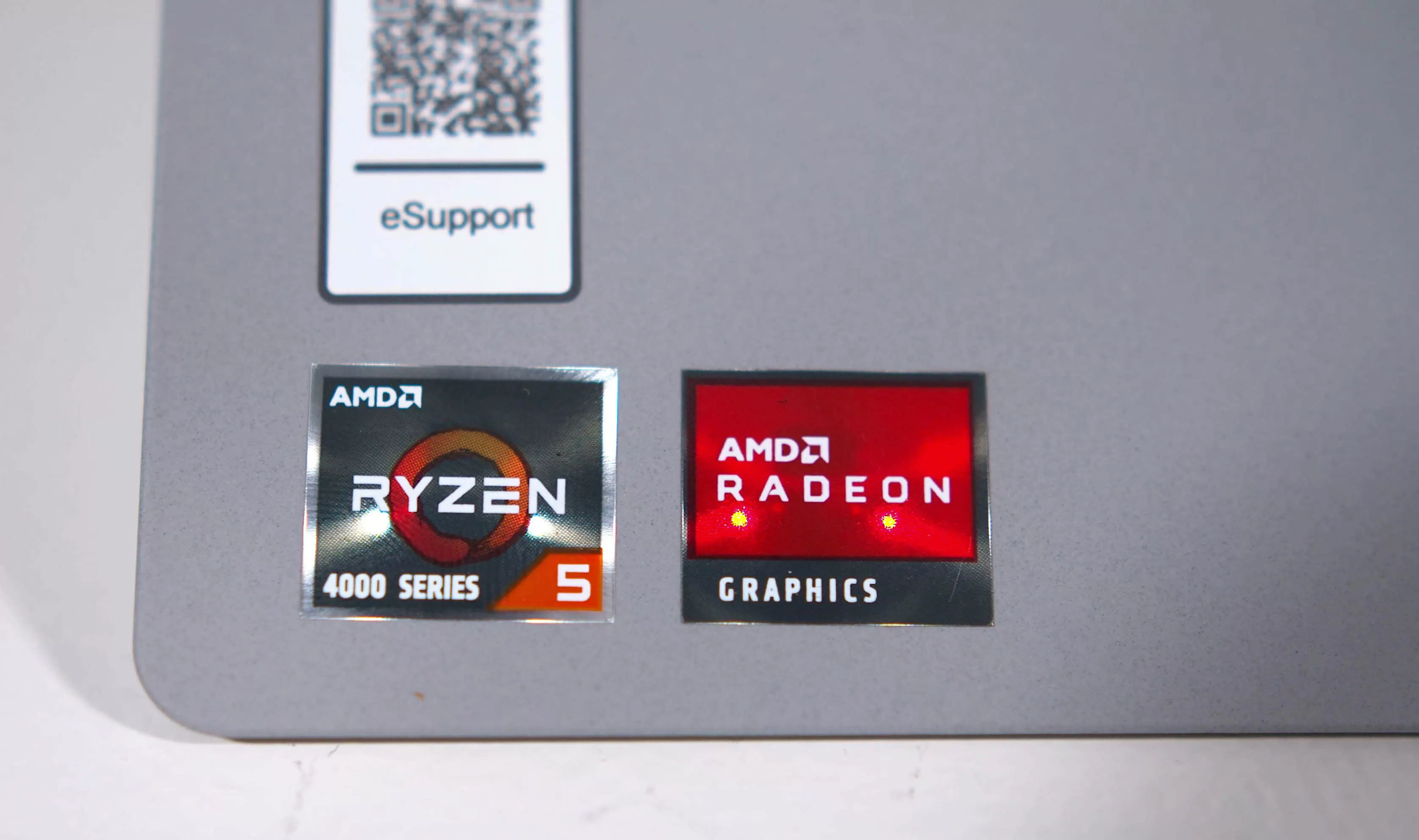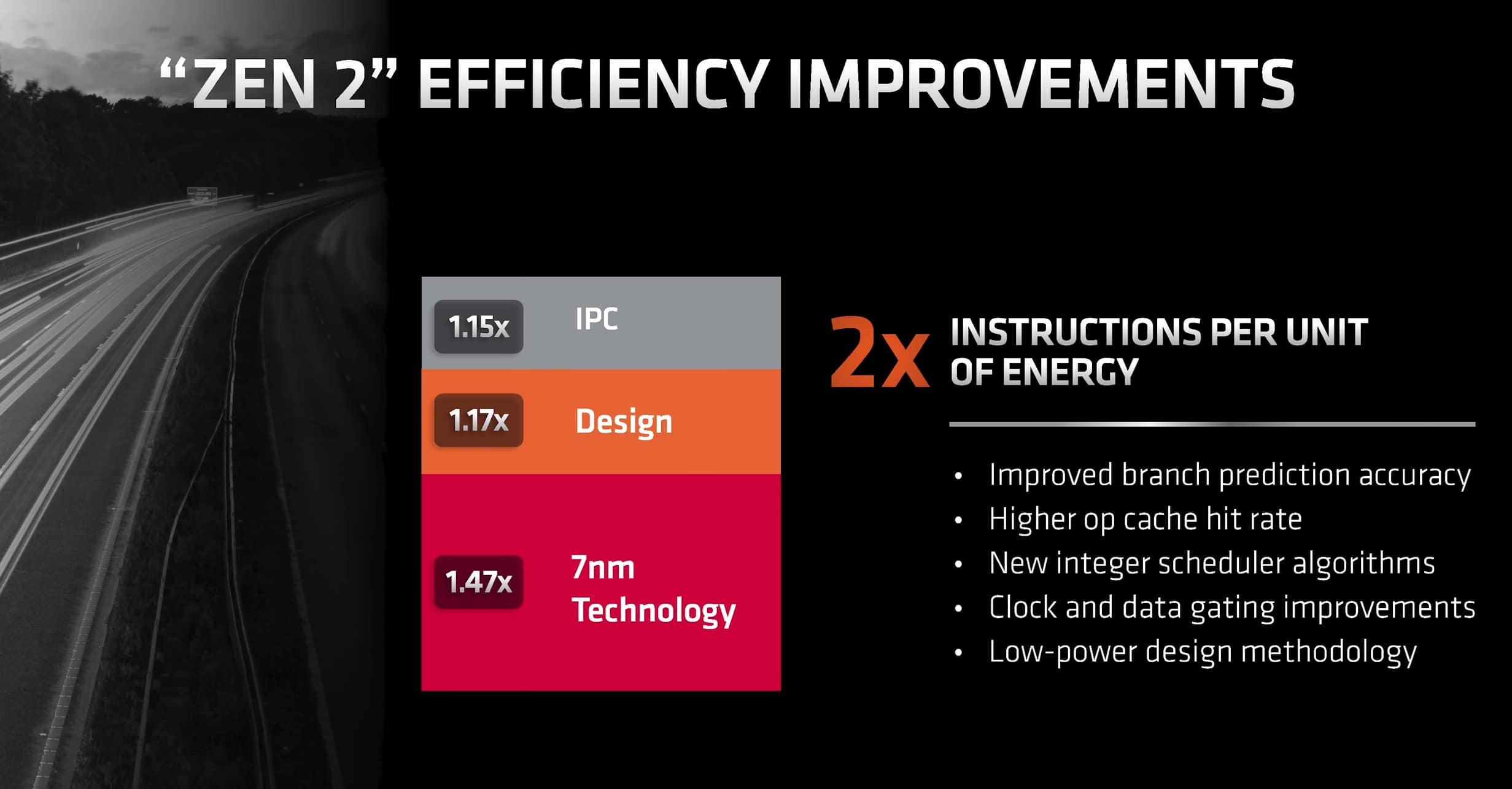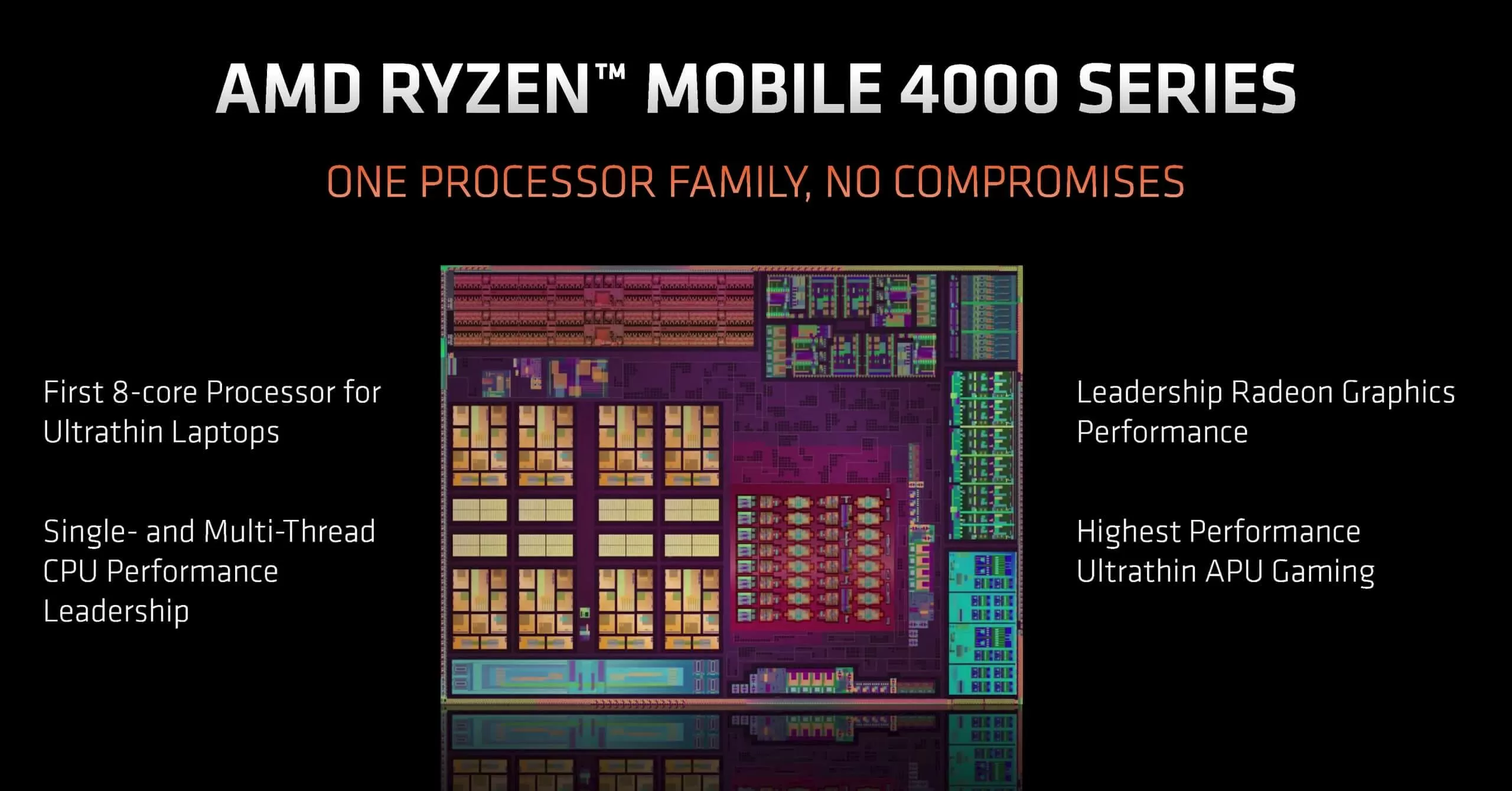This is our first review of AMD's Ryzen Mobile 4000 U-series processors, the low power variants intended for slim, light, ultraportable laptops. Our exploration will start in the mid-range with the Ryzen 5 4500U, a 6 core and 6 thread part with a 2.3 GHz base and 4.0 GHz boost, alongside 8 MB of L3 cache and 6 Vega GPU compute units clocked up to 1500 MHz. All with a default TDP of 15W.
When you look at AMD's Ryzen 4000 line-up, this isn't the lowest-end part, there is a Ryzen 3 4300U on the market with just four cores, but the 4500U is the next step up.
AMD's segmentation in the U-series mostly deals with core and thread counts, so this Ryzen 5 4500U gets an impressive 6 cores, but without SMT. The 4600U, one step higher adds back in SMT. Then Ryzen 7 parts both have 8 cores, which we'll hopefully get some hands-on time with soon.
These Ryzen 4000 APUs are Zen 2-based, the same architecture powering 3rd-gen Ryzen desktop CPUs under the Ryzen 3000 brand. Upgrades over previous generation APUs includes the increase in core count, depending on the model, but there's also a change to the GPU layout.
While this APU still uses the Vega architecture and has fewer compute units, at 8 down from 11, AMD has heavily optimized the design for 7nm, so we see higher clocks and better performance overall.
Other important upgrades include support for DDR4-3200 and LPDDR4X-4266 memory, upgraded display and multimedia engines, and significant improvements to battery life through efficiency optimization. It's a fundamental overhaul of AMD's mobile offering that makes them more competitive with Intel's powerhouse line-up, as we've seen demonstrated with the H-series that comfortably beats Intel's options in many productivity tests.
Main competition for Ryzen Mobile 4000 and the Ryzen 5 4500U comes from Intel's split U-series that has both Comet Lake and Ice Lake chips available. Some popular options include the Core i5-10210U on the Comet Lake side, and the Core i5-1035G1 on the Ice Lake side. However, given what we've seen with AMD's higher power mobile parts, it's likely the Ryzen 5 4500U will deliver competitive performance with Core i7 CPUs, as we'll see in the coming benchmarks.
For today's benchmarking, we've used Lenovo's IdeaPad 5 14". This is not a full review of the laptop and honestly we're not sure what we think of it yet – the display is really bad though at 66% sRGB panel, which is disappointing.
The IdeaPad 5 offers two power profiles which run the Ryzen 5 4500U at unusual limits. The "intelligent cooling" mode lead to a long term package power limit of 19W, while the "extreme performance" mode clocked it up to 26W. We'll be showing the performance in both profiles where possible.
This laptop also has 16GB of dual-channel DDR4-3200 memory, as opposed to LPDDR4X. We suspect this will be a common configuration for mid-range to entry-level systems, while the higher-end stuff will use LPDDR4X memory. Just something to keep in mind.
As usual, our laptop benchmark results are an average across systems of the same configuration. We test with dual-channel memory where possible and try to make a fair comparison, though this can be tricky with laptops. You can see the full list of laptops we tested here.
Benchmarks
Let's kick this one off with a look at Cinebench R20. As we've come to expect with Ryzen, the Ryzen 5 4500U does very well in this benchmark, particularly when looking at multi-core. In its 26W configuration, the 4500U is able to get within the ballpark of Intel's six-core H processors, including the Core i7-9750H and Core i7-10750H. Meanwhile it finishes ahead of the flagship Comet Lake Core i7-10710U despite only having six threads versus twelve in the Intel part.

The 4500U also easily beats the Core i7-1065G7 in multi-thread workloads. This is Intel's best Ice Lake processor on 10nm, but because it only has four cores it cannot get close to the 4500U, even when using 25W of power. The 4500U is around 50% faster at 26W, which is an enormous discrepancy. The difference between 19W and 26W isn't very large in this test as the Ryzen APU is able to boost for quite a while, often up to around 36W or so.
In terms of single-thread performance, the 4500U is also impressive, as it can run up to the 4.0 GHz turbo on a single core without exceeding the power limit. This allows it to deliver, in a worst case situation, equivalent performance to Ice Lake, or better performance than almost every other processor in this chart, especially U-series parts built on 14nm.
We also are seeing a substantial generational leap for AMD's U-series. The Ryzen 5 4500U is over 80% faster than the Ryzen 5 3500U, albeit with a 4W increase to power in our test configuration thanks to Lenovo's weird settings. However it's clear the 4500U is a huge leap for efficiency.

Video encoding is traditionally not something you would do on an ultraportable as 15 - 25 watt processors are not fast at this. However, the Ryzen 5 4500U makes a case that a U-series laptop is capable of video encoding in Handbrake, with x265 instructions.
As seen on the chart, this long-term workload is approximately as fast as Intel's six-core H processors when the 4500U is able to consume 26W of power. Even at 19W, the 4500U delivers impressive performance, far outstripping Intel's U-series parts.
The margin is so large in some situations, it's a bit of a bloodbath. For example, the 26W 4500U is 52% faster in Handbrake than the 25W Core i7-1065G7, and exactly double the performance of Intel's Core i5-10210U, which is a quad-core Comet Lake processor. While we wouldn't want to encode videos on any of Intel's U-series CPUs, the 4500U starts to put ultraportables in the frame for heavier productivity tasks.

The same story continues with a look at Blender. Normally this is a workload you wouldn't want to run on an ultraportable, with perhaps the exception of the Core i7-10710U at 25W. But the Ryzen 5 4500U approaches the performance of six-core H-series parts, while outperforming every other Intel U-series option. The margins to Ice Lake are significant, with a 40% gain at 25W and over 60% at the lower power targets.

One of the most impressive use cases for the Ryzen 5 4500U is code compilation. The 26W variant performs at the level of a Core i7-10750H in this workload, while the margin to Ice Lake with the 19W configuration is 38%, for just a 4W increase in long term power draw. This could make a huge difference for those wanting quick compilations in a mixed multi- and single-threaded compile.

With some heavier workloads out the way, let's see how the 4500U does in more relevant workloads to an ultraportable. Here is Excel with a large number crunching test. The 4500U is outperformed here, marginally, by Ice Lake with both CPUs using similar power in their burst state. But given the 1065G7 is a higher tier processor, and the 4500U beats parts like the Core i5-10210U, this is still a good showing from AMD.

While our Excel benchmark is reasonably heavy, PCMark's productivity test is on the lighter side. In this mixed benchmark, the Ryzen 5 4500U holds a significant performance lead, matching the Ryzen 5 4600H, likely because significant aspects to this test are lightly threaded.
What we end up with is better light productivity performance than Intel's 14nm and 10nm processors. The 4500U is 7 to 15% faster than the Core i7-1065G7, and over 10 percent ahead of the 10210U.

It's a similar story in the Essentials test, which covers web browsing and app loading. In the worst case for Ryzen, it's marginally ahead of Ice Lake's best 25W processor, which given the 4500U's mid-tier position is fantastic. Compared to other parts, such as the 10210U and older chips like the Core i7-8565U, we're seeing more substantial gains.

In 7-Zip we see strong results from Ryzen. The 4500U isn't faster than Intel's Core i7-10710U with equal power limits, but it does outperform every other relevant chip, including the Core i7-1065G7 and even some of Intel's quad-core H processors. This bodes well for a workload that is common for productivity and important for ultraportable type devices.

Cryptography performance sees the Ryzen 5 4500U fall behind the Core i7-1065G7 in a rare loss for Ryzen. However, the 4500U is still in the ballpark of other U-series processors.

MATLAB is another strong result for Ice Lake, with the Ryzen 5 4500U sitting in the class between the 1065G7 and other U-series processors, like the Core i5-10210U. Not a bad result for the 4500U, especially as the 1065G7 is a higher tier part, however for MATLAB there is a reason to go for a more premium notebook processor.

And now we get to everyone's favorite PDF exporting benchmark. This is a test that was horrible for previous Ryzen mobile generations. But with superior single-thread performance, the 4500U fares much better here. It isn't as fast as the Core i7-1065G7, losing by around 7%, but sits somewhere in the middle and does get close to Intel's 14nm U-series processors, especially the quad-core variants.

Adobe Photoshop is another productivity workload that we feel is reasonable for an ultraportable laptop. While Intel generally holds a lead in this benchmark when looking at H-series parts, it's a different story for U-series. The Ryzen 5 4500U is seen offering comparable performance to the Core i7-1065G7. With significant parts of Photoshop still being lightly threaded at best, AMD's equivalent single-thread performance is doing the job. You can see just how much worse older Ryzen processors are.
Normally we'd show you Adobe Premiere benchmarks next, but the latest update doesn't play nicely with ultraportable hardware. With the Ryzen 5 4500U, Premiere still does not allow some GPU accelerated effects to run on the Vega GPU, such as the Lumetri filter. AMD says this is Adobe's fault, and that Ryzen Mobile 4000 should be capable of running GPU accelerated filters. Meanwhile, the latest update has, in its attempts to increase GPU accelerated encoding, fully broken support for the MX250. Not to mention that this type of video encoding relies heavily on discrete GPUs now, and isn't a great use case for any ultraportable system.

You can see this in action with Puget's DaVinci Resolve benchmark. While the Ryzen 5 4500U is faster than the Core i7-1065G7 in this test, most H-series laptops with a discrete GPU are 4 to 5 times faster. So while Ryzen U-series parts are great for CPU-limited productivity, any time you want GPU acceleration, an ultraportable is not the right sort of system for that task.
Gaming Tests
Aside from some light GPU acceleration, the main use case for the integrated GPU in the Ryzen 5 4500U is gaming at low settings. Let's run through a few benchmarks and see where AMD's refreshed Vega GPU fares when cut down to 6 compute units.

In Grand Theft Auto V at low settings running at native 1080p, the 4500U is able to provide a performance lead over Ryzen 3000 APUs, beating the Ryzen 7 3750H. With the 4500U providing around 60 FPS on average, this is playable using just integrated graphics.
We also see the 4500U providing a notable performance lead over Intel's Ice Lake Core i7-1065G7 when configured to 25W. However, Nvidia's MX250 remains the preferred choice for this title, with the 4500U unable to outperform Nvidia's basic discrete option. We'll see how that changes when all the Vega CUs are unlocked when we test the Ryzen 7 4800U later.

The situation is a bit different in Civilization VI. This is a game that Ryzen processors love, with the 4500U massively outperforming Ice Lake and even the MX250. Not only that, but the 4500U leaves older Ryzen APUs in the dust, especially the 3700U, although there is a power configuration difference here.

CS:GO hits both the CPU and GPU at lowest settings with mobile processors. The Ryzen 5 4500U performs well, but Ice Lake is ~15% faster in its G7 graphics configuration with everything unlocked. Still, given the 4500U is a cut down processor, it's a good result, outperforming the MX250.

Gears 5 represents a more heavily GPU limited game running at medium settings, which is a bit unrealistic on ultraportable laptops. Here, the 4500U is 17 percent faster when comparing average frame rates, to the Core i7-1065G7, but it falls behind the MX250. However we do get, in combination with a higher power limit, around double the frame rate of AMD's 3500U.
Performance Breakdown
Before jumping into the conclusion, let's see some performance comparisons. We'll with the Ryzen 5 4500U versus the Core i7-1065G7, when both have roughly the same power limit. It would have been nice to compare the Ryzen 5 APU against a Core i5 from Intel's Ice Lake series, but we think the point can be made just fine anyway.
This is comparing AMD's mid-tier Ryzen 4000 APU, to Intel's best 25W offering with Ice Lake.

At lower power limits it's harder to make a fair comparison, but you can expect Ryzen to be faster here as well, except in a few edge cases. Single-thread performance is largely equivalent, while multi-thread workloads see Ryzen take the crown.

In a more reasonable class comparison, here we have the Ryzen 5 4500U up against the Core i5-10210U. While the Ryzen processor is consuming 4W more power, this allows the CPU to provide up to double the performance of Intel's Comet Lake quad-core in multi-thread workloads.
The 4500U is also 5 to 10% faster in single-thread tests, and generally delivers a far superior experience when you also factor in the enormous gap in GPU capabilities.

While not really a fair battle, the Ryzen 5 4500U can be a reasonable ultraportable substitute for the Core i7-10750H in some workloads, which is very impressive. It's single-digit percentages behind in tests like Handbrake, Cinebench, light productivity and GCC compilation.
That's not to say buying a U-series processor instead of H-series always makes sense, because the 4500U isn't in the same class for things like video editing, but depending on how you use your laptop, there might be no reason to go for a six-core H-series Intel system.

And finally we have the gen-on-gen performance difference between the Ryzen 5 3500U and Ryzen 5 4500U. There is a 4W power difference, but we are seeing very substantial performance gains. Workloads like Handbrake are well over twice as fast, and single-thread performance is improved by over 25%.
What We Learned
All things considered, the Ryzen 5 4500U is an impressive mid-range low-power processor. The Zen 2 architecture is able to deliver an enormous performance gain over the previous generation when scaled down into a 25W power envelope or lower. Single-thread performance is way up, now matching or exceeding Intel's U-series parts, while multi-thread performance benefits significantly from six CPU cores, even if SMT is disabled on this particular chip.
In a way, AMD is redefining the sort of workloads an ultraportable laptop is suitable for. Before you might have chosen a six-core Intel H-series laptop for video encoding, code compilation or CPU based rendering because U-series components are too slow. But the Ryzen 5 4500U approaches the performance of a Core i7-10750H in many of these tasks, making a U-series laptop suitable for genuine video encoding or coding work for the first time.
One could argue the 4500U is a better choice than Intel's best mainstream Ice Lake processor, the Core i7-1065G7, despite not really competing in terms of class or price. And this may be AMD's weakest point in mobile at the moment, when you cannot find these APUs on flagship laptop models that have the nicest build quality and accompanying components.
When matching up the Ryzen 5 4500U against a Core i5 part like the 10210U, Intel's competing part is just not up to scratch. If the option you have is between a 4500U system or a Core i5 system at the same price, it's an absolute no brainer, the 4500U is giving you so much more.
AMD is also delivering good integrated GPU performance. In the Core i5 bracket it's an easy victory for Ryzen, but the 4500U is also able to outperform Intel's fully unlocked Core i7-1065G7 most of the time. This makes the 4500U suitable for light gaming, whether that's casual games at modest settings, or even some higher performance titles at the lowest settings.
We're also happy to report no glaring software issues with this Ryzen 4000 laptop (which we purchased from retail shelves, it's not a review sample). The launch of the first Ryzen Mobile series was plagued with issues, many of which were showstoppers and related to bugs with the GPU.
What remains an unknown at this point is battery life. Anecdotally the battery life from the IdeaPad 5 seems decent, but Intel CPUs are particularly good in this department, especially Ice Lake. For what it's worth, AMD is claiming similar battery performance to Ice Lake, helped largely by their more efficient CPU. AMD doesn't expect to win for idle battery consumption.
Moving forward, and having completed testing on this mid-range Ryzen Mobile 4000 part, we're excited to discover what's possible with the 8-core models, especially the Ryzen 7 4800U. It's possible the 4800U will outperform a number of H-series processors and be a superb choice for CPU-limited productivity, but we'll have to wait and see when we finally get some hands on time with those laptops.
